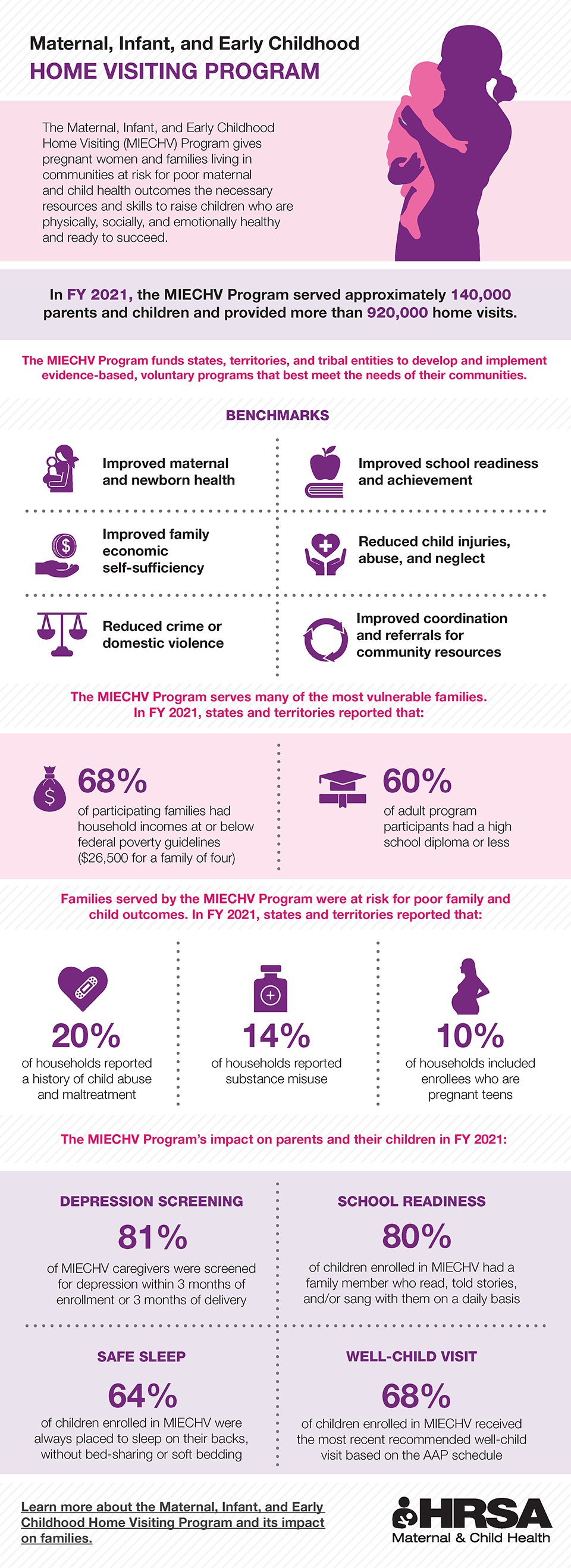The Maternal, Infant, and Early Childhood Home Visiting (MIECHV) Program supports pregnant people and parents with young children who live in communities that face greater risks and barriers to achieving positive maternal and child health outcomes. Families choose to participate in home visiting programs, and partner with health, social service, and child development professionals to set and achieve goals that improve their health and well-being.
The program aims to:
- Improve: maternal and child health
- Prevent: child abuse and neglect
- Reduce: crime and domestic violence
- Increase: family education level and earning potential
- Promote: children’s development and readiness to participate in school
- Connect: families to needed community resources and supports
How Home Visiting Helps Communities And Families
Home visitors and families develop strong relationships and trust through meeting regularly and addressing families’ needs.
Home visitors:
- Support healthy pregnancy practices
- Provide information on topics such as breastfeeding, safe sleep, preventing unintended child injuries, and nutrition
- Encourage early language development and early learning at home
- Teach positive parenting skills like reading, playing, and praising good behaviors
- Work with caregivers to set goals for the future, continue their education, and find employment and child care solutions
- Connect families to other services and resources in their community
How We Implement This Program
In partnership with the Administration for Children and Families (ACF), we fund states, territories, and tribal entities to develop and implement home visiting programs. These programs must be based on the best evidence showing that they are effective at meeting the needs of families.
- FY 2022 Formula Funding Awards
- FY 2021 American Rescue Plan Act Awards
- FY 2021 Formula Funding Awards
- FY 2020 Formula Funding Awards
- MIECHV Innovation Awards
- Tribal Home Visiting Program
How We Ensure These Programs Work
The Home Visiting Evidence of Effectiveness (HomVEE) review conducts a thorough and transparent review of home visiting program models to ensure they effectively meet family needs. There are currently 20 home visiting models that meet HomVEE and other eligibility criteria. States, territories, and tribal entities have the flexibility to select eligible home visiting models that are the best fit for their communities.
Awardees must report on their program’s performance for 19 measures across six statutorily defined benchmark areas and demonstrate improvements in at least four benchmark areas.
We provide technical assistance support to awardees to help them implement home visiting models, meet performance goals, and improve services to families.
How We Support Communities And Families in Response to COVID-19
We awarded about $121 million in funds through the American Rescue Plan Act (PDF - 681 KB) to current MIECHV awardees to support children and families affected by the COVID-19 pandemic. ARP funds are being used to meet the emergency needs of families. Examples include:
- Providing needed emergency supplies for families, including groceries, diapers, and other supplies
- Providing training for home visitors, including training to identify and address families’ mental health needs
- Providing funds for home visitor hazard pay or other staff costs, including overtime for home visitors to reach families who are unable to participate in home visiting during regular work hours
Learn more about how home visiting programs have supported families during the COVID-19 pandemic.
Resources for Our Awardees
- COVID-19 Resources and FAQs for Home Visiting
- Technical Assistance for Awardees
- Data, Evaluation, and Continuous Quality Improvement for Programs
- Discretionary Grant Information System (DGIS)
Additional Briefs, Fact Sheets, And Media
- Program Brief: Maternal, Infant, and Early Childhood Home Visiting Program (PDF - 851 KB)
- Home Visiting Program State Fact Sheets
- Early Childhood Systems
- Demonstrating Improvement in the Maternal, Infant, and Early Childhood Home Visiting Program: A Report to Congress (PDF - 1 MB)
- MIECHV Awardee Video: Why Home Visiting Matters
- FY 2021 Home Visiting Infographic (PDF - 450 KB)

Which one is right for you? (PDF - 450 KB)